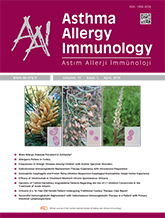


Objective: Eosinophilic esophagitis is a chronic inflammatory disease characterized by eosinophilic infiltration and esophagus dysfunction symptoms. Proton pump inhibitor responsive esophageal eosinophilia is similar to eosinophilic esophagitis in terms of clinical, laboratory, genetic expression profile, endoscopic and histopathological features. In this study, we aimed to share demographic features, clinical, laboratory and histopathological findings, and treatment outcomes of patient with eosinophilic esophagitis and proton pump inhibitor responsive esophageal eosinophilia.
Materials and Methods: Demographic features, laboratory, endoscopic and histopathological findings, and treatment outcomes of patients followed in our clinic were recorded retrospectively since January 2010.
Results: Four thousand six hundred fifty five patients underwent esophagogastroscopy since 2010 in our clinic and 0.4% (n=18) of these patients were diagnosed with eosinophilic esophagitis, and 0.2% (n=8) with proton pump inhibitor-responsive esophageal eosinophilia. The main symptom of patients with eosinophilic esophagitis were food impaction/dysphagia (n=5, 27.8%) and chronic abdominal pain (n=5, 27.8%). Allergen sensitization was found in 14 (77.8%), increased IgE in 12 (66.7%), peripheral eosinophilia in 12 (66.7%), and food allergen sensitization in 10 patients (55.6%) with eosinophilic esophagitis. On histopathological examination, the mean intraepithelial eosinophil count was 48.9 ± 30.9 cells / HPF (400x). When patients with eosinophilic esophagitis (group 1) and proton pump inhibitor-responsive esophageal eosinophilia (group 2) were compared, it was found that chronic abdominal pain was more common in the proton pump inhibitor-responsive esophageal eosinophilia group and food allergen sensitization in the eosinophilic esophagitis group (p<0.05). Total IgE, peripheral eosinophil count and intraepithelial eosinophil count were higher in the eosinophilic esophagitis group, but the differences were not statistically significant. Diet (n=11), medical (n=17) and dilatation (n=1) therapies were used in the eosinophilic esophagitis group. Fibrosis was detected on the histopathological examination in two patients who underwent TED and then SED was started. No side effect was seen any group in long term.
Conclusion: Eosinophilic esophagitis and proton pump inhibitor-responsive esophageal eosinophilia have similar laboratory and histopathological features but eosinophilic esophagitis should be suspected more frequently in the presence of food allergy. Long-term followup is essential in patients with eosinophilic esophagitis.